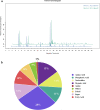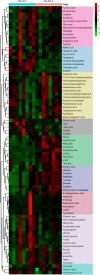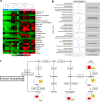Comparative genomics and metabolomics analysis of Riemerella anatipestifer strain CH-1 and CH-2
- PMID: 33436670
- PMCID: PMC7804117
- DOI: 10.1038/s41598-020-79733-w
Comparative genomics and metabolomics analysis of Riemerella anatipestifer strain CH-1 and CH-2
Abstract
Riemerella anatipestifer is a major pathogenic microorganism in poultry causing serositis with significant mortality. Serotype 1 and 2 were most pathogenic, prevalent, and liable over the world. In this study, the intracellular metabolites in R. anatipestifer strains RA-CH-1 (serotype 1) and RA-CH-2 (serotype 2) were identified by gas chromatography-mass spectrometer (GC-MS). The metabolic profiles were performed using hierarchical clustering and partial least squares discriminant analysis (PLS-DA). The results of hierarchical cluster analysis showed that the amounts of the detected metabolites were more abundant in RA-CH-2. RA-CH-1 and RA-CH-2 were separated by the PLS-DA model. 24 potential biomarkers participated in nine metabolisms were contributed predominantly to the separation. Based on the complete genome sequence database and metabolite data, the first large-scale metabolic models of iJL463 (RA-CH-1) and iDZ470 (RA-CH-2) were reconstructed. In addition, we explained the change of purine metabolism combined with the transcriptome and metabolomics data. The study showed that it is possible to detect and differentiate between these two organisms based on their intracellular metabolites using GC-MS. The present research fills a gap in the metabolomics characteristics of R. anatipestifer.
Conflict of interest statement
The authors declare no competing interests.
Figures




References
Publication types
MeSH terms
Substances
Supplementary concepts
LinkOut - more resources
Full Text Sources
Other Literature Sources
Miscellaneous

